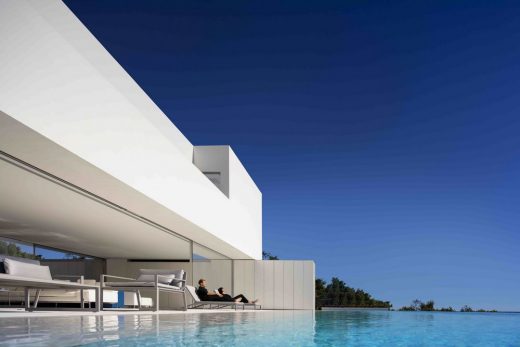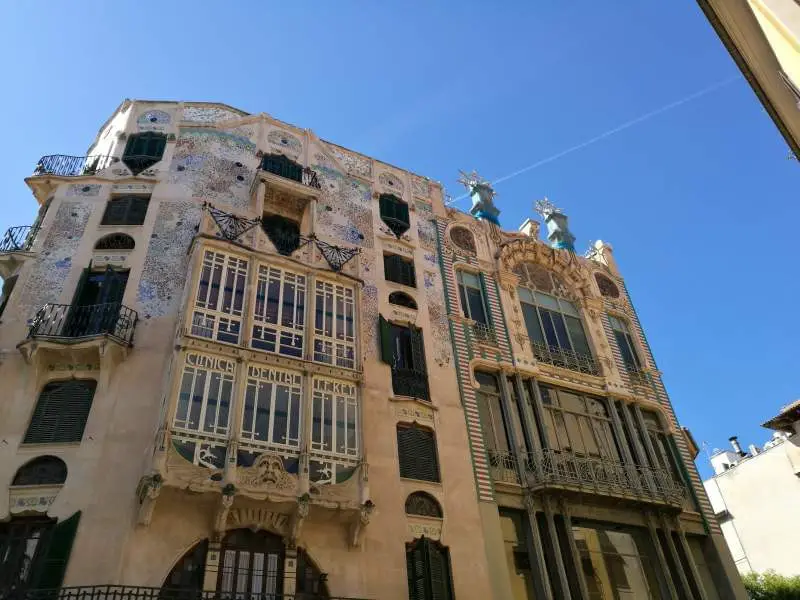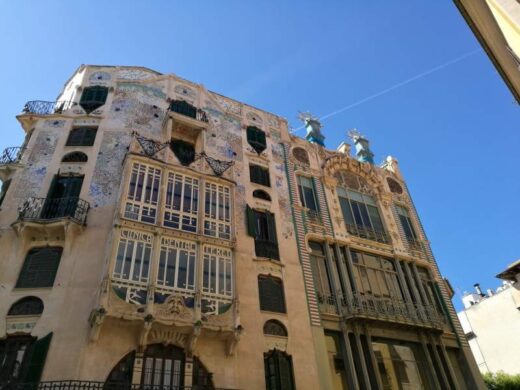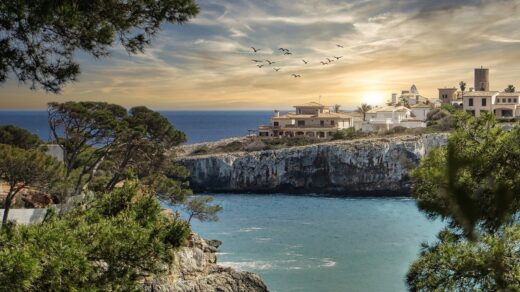Catalan Modernisme in Mallorca Spain, Balearic Islands homes advice, Spanish property guide
Catalan Modernisme in Mallorca
23 July 2022
14 stunning examples of Catalan Modernisme in Mallorca
Architecture in the Balearic Islands is often times neglected by journalists, tourists and bloggers because they are so focused on beaches, good food and luxury accommodation.
It is true that when talking about architectural wonders in Spain, Barcelona, Valencia, Bilbao, Sevilla and Madrid tends to (rightfully) steal the headlines and paragraphs. However, the Balearic Islands, and namely Mallorca, too should get some attention when it comes to great building facades and structures. The island is after all visited by 14 million tourists every single year, making it one of Europe’s most sought-for travel destinations.
So what architecture is worth having a closer look at in Mallorca? Of course, some of the Catalan Modernisme and Art Nouveau which is particularly present in Palma and Sóller is well worth visiting for the nature inspired artistic facades. But also, have a close look at some of the churches in Mallorca. Many of them represent stunning ecletical architectural styles, including Levantine Gothic, Gothic revival, Renaisance and Baroque.
In this article, we will focus on the Catalan Modernisme movement and its impact on Mallorca.
What is Catalan Modernisme?
Catalan Modernisme, or simply just Modernisme, is closely linked to Art Nouveau, an architectural style interested in moving away from philosophies, particularly Classicism and Historicism, of prior centuries. Catalan Modernisme was, unlike the similarly spelled Modernism, characterized by serpentine curving forms and detailed ornamentation. It was inspired by nature and often expressed in decorative leafy and flowery forms that gave a certain contrast or nuance to the building. Typical places to make use of the style was on balconys, roofs, fences, door and window frames. The style was very popular in the years between 1890 and 1920.
In Catalonia, Antoni Gaudí is known as the grand old man of Catalan Modernisme. He took the idea of bringing nature into buildings to the next level. Gaudí was known for his geometric forms such as the hyperboloid, the cone and helicoid, all of which reflect structures found in nature.
”Anything created by human beings is already in the great book of nature.” – Antoni Gaudí
Gaudí is first and foremost famous for the magnificent Sagrada Familia cathedral in Barcelona, a Roman-Catholic cathedral that still, after more than 100 years of construction work, is not finalized due to the great complexity in the thoughts of its author. Once you visit the Sagrada Familia in Barcelona, you will understand the mindset of Gaudí and the Catalan Modernisme.
There were more than 100 architects designing buildings in the Catalan Modernism style, and the movement was not only limited to architecture but also represented an ideology that was to distance Catalonia as an individual state.
Besides from Antoni Gaudí, some of the most influential archietcs of the Catalan Modernisme movements include Lluís Domènech i Montaner, Josep Puig i Cadafalch, Joan Rubio i Bellver, Josep Maria Jujol, Cèsar Martinell i Brunet, Enric Sagnier i Villavecchia, Josep Vilaseca i Casanovas and Lluís Muncunill i Parellada.
Catalan Modernisme in Mallorca – Best Buildings
Gaudí has too been working in Mallorca, most famous for his reformation of the Palma cathedral of La Seu and the church of the Santuari de Lluc monastery.
But Gaudi was not alone in creating masterful architecture in neither Catalonia or in Mallorca. There are a number of architectural wonders to discover all over Mallorca done by different famous architects and in different architectural styles. To find the best architecture in Mallorca, you will have to travel on the island exploring different places, but you are sure to be rewarded with many beautiful buildings and constructions to marvel at. However, as initially stated, most of the unique and best architecture is found in the city of Palma and in the town of Sóller.
Catalan Modernisme was introduced in Mallorca with works of Palma cathedral by Gaudi, Rubio and Jujol, but shortly after more singular buildings were erected. Part of the reason why the Catalan Modernisme and Art Nouveau came to Mallorca was due to the rise of the new social elite that erected from businessmen returning from Latin America and France with great fortunes. Grandiose mansions and commercial buildings were erected on commission of this new social elite. Some of the early examples include the 1903 Gran Hotel in Palma, the 1904 main facade of the church of Sóller and the 1911 Cas Casasayas in Palma.
Modernisme highlists in Palma
Palma holds towards 40 architectural examples of Catalan Modernisme, which tells us of a great cultural impact from the mainland. If you spend a few days visiting Palma de Mallorca, or you simply like modernisme architecture, you cannot miss this route through the most beautiful modernisme buildings in the center of Palma. An itinerary in the heart of the historic center that will take you out of the medieval streets and courtyards to discover the happiest and most creative side of the architecture of the Balearic capital.
Palma Cathedral
The cathdral is a an incredible work of art which many big architetcs has been contributing to. The cathedral carries styles of Levantine Gothic, late Gothic, Renaisance and Baroque.
Gaudi have had a major influence on many of the architectural wonders of Mallorca, particularly the amazing La Seu cathedral by the waterfront in Palma, which he worked on with Josep Maria Jujol and Joan Rubio i Bellver to create a universe in motion inside the old Gothic temple. Among other things, Gaudi opened the windows to allow the sunshine to pierce through the stained glass creating a unique colorscheme inside the Gothic temple and highlights the beautiful details that would make it a perfect place for prayers.
However, Gaudi alone is not responsible for this beauty, which is one of Europe’s biggest cathedrals. Names such as Miquel Barcelo, Ponç Descoll and Berenguer de Montagut, have all had a role to play in the construction of the great cathedral in Palma.
”Sunshine is the best painter” – Antoni Gaudí
The cathedral is an eclectic wonder of architecture, one of the must visit sights on your sightseeing in Palma de Mallorca. It is located at the waterfront of the historic city center of Palma casting reflections into the artificial lake beneath it in the Parc de la Mar (Park of the Sea), a common meeting point for sightseeing tours in Palma.
Gran Hotel
The former Gran Hotel in Palma was the first building covered in Catalan Modernism. It was completed in 1903 by famous architect Lluís Domènech i Montaner, whom was also considered one of the earliest Catalan Modernism architects being the author behind the Castle of the Three Dragons in Barcelona, from 1888, and was one of the first luxury hotels in Mallorca. The facade was decorated with ceramic elements and with the sculptural touch of Alfons Juyol. It is situated on the Place Weyler downtown.
Cas Casasayas
Its sinuous and wavy facades favor the dynamism of the buildings, in which nature is manifested through butterflies, ferns and acanthus. Josep Casasayas, owner of the pastry shop in Can Frasquet, ordered the construction of the works, which was carried out by Francesc Roca. It was finished under the direction of Guillem Reynés, in 1911. Cas Casasayas stands on Plaça del Mercat characterized by two symmetrical buildings, designed with the idea of becoming architecturally identical. The Casasayas and the Pensió Menorquina project had the same identity.
El Águila
Right next to the Plaça Major you will find one of the most significant examples or Art Nouveau in Palma, the El Aguila building. It was constructed as a department store in 1908, designed by Palma’s preferred architect Gaspar Bennassar, whom was also one of Mallorca’s most influential architects throughout history. The structure consists of four floors with floral decorations. The balconies on the facade are made of corrugated iron, which brings a great dynamism typical of this current. Continuing with a functional objective, the iron columns allow the installation of glass windows to obtain greater interior lighting.
Can Corbella
In Plaça de la Cort stands the Can Corbella, a pre-modernist, neo-Mudéjar building constructed at the end of the 19th century, an idea of Nicolás Lliteras. Can Corbella was born as a commissioned work, it had to become a multi-family housing building. On the first floor you notice the colorful cabinets and horseshoe arches. The facade follows with elongated windows, ornaments and lobed decorations on the upper floors. The rooftop is crowned with a beautiful octagonal towerthat can be spotted from a far.
Can Barceló
Can Barceló is another splendid example of Art Nouveau in Palma, with its glazed ceramics shaped like butterflies and tiles with botanical motifs. Can Barceló is a work of Bartomeu Ferrà Perelló, while the stunning tiles were designed by draughtsman Vicenç Llorens. Each tile represent allegories of music, litterature, architecture, ceramics, the textile industry and trade. You will also see two tiles ornamented with eagles and dragons. Can Barceló stands on Plaça de Quadrado.
Forn des Teatre
The careful decoration of Forn des Teatre, a commercial premises, reflects an immense work done in wood. A golden dragon guards the door and the windows are guarded by eagles. Of course, there are also floral and plant motifs. The modernist spirit did not only varnish monuments and grandiose buildings, as we have already seen, which illustrates the influence that the aesthetic trend had in Mallorca.
Casa Forteza Rei
The colorful layer of polychrome ceramics and Modernisme pique assiette that is projected on the facade of Casa Forteza Rey near the city center of Palma always attracts attention from shoppers and pedestrians. Casa Forteza Rey is by far one of the most photographed buildings in the heart of Palma. Designed by the jeweler Lluís Forteza Rei, decorated with floral motifs and ornamented with wrought iron, it receives great influences from Catalan Modernism and this can be seen in the great similarities with the work of Antoni Gaudí.
Casa de les Mitges
Casa de les Mitges is a historical landmark in Palma. It is located in the Carrer des Colom, and easily recognized by its unique triangular red balconies on the facade. The building too carries signs of Gaudí’s influence on Palma’s architecture from the early 20th century. Lluís Forteza Rei was too the architect behind this wonder, he probably met Gaudí himself as his father Josep was the goldsmith of the Palma Cathedral. And this contact was decisive in understanding the uniqueness of this building, which he designed and directed in 1906.
The materials used in its ornamentation are stone on the ground floor, exposed tiles up to the second floor and a rough texture on the rest of the facade. The decoration is based on the wooden panels with curvilinear and vegetal moldings, the mosaics under the balconies, and the circular ceramic panels are from the first stage of the La Roqueta tile factory. The two balconies on the fourth floor, with a triangular plan, attract attention.
Caja de Ahorros
This urban mansion was designed by famous Gaspar Bennassar, in 1906. It is located on Carrer de Ramon Llull, across from the famous Sant Francisc convent and church in the historic center of Palma. The building facade carries traces of modernist, modernism and historicism architectural styles
Modernisme in Sóller
Sóller is a township and valley located deep in the UNESCO World Heritage site of Serra de Tramuntana, on the western side of mallorca. The valley is particlularly known for its lush landscapes and high temperatures which makes it perfect for growing oranges and lemons. This has too been a protagonist in the development of the town and the many stunning examples of Catalan Modernisme here.
A colorful walk of great architectural beauty and an enviable heritage Modernisme arrived in Sóller at the end of the 19th century thanks to the migratory movements of its inhabitants, who imported Art Nouveau from a more modern Europe.
When prosperity returned to Sóller in the early 20th century, the town was enriched and impacted by the modernisme fever that reigned in Europe at the time, particularly in France and Belgium. This is how Sóller redefined its urban style in favor of ornaments, aesthetics and fashion. A walk through the picturesque town of Soller will take you to a time period when Sóller was breathing new airs arrived from overseas, and we will see how all this coexists in perfect harmony with the rural image that still reigns in this mountain town.
Ca s’Americas
Ca s’America is a building of Modernist style, but the iron railing separating the property from the public street is typical Art Nouveau with its ornamental style imetating nature’s structures. Ca s’America was built in 1920 be architect Manuel Carrascosa.
Can Prunera
Can Prunera is one of Sóller’s most eminent examples of Catalan Modernisme and Art Nouveau, built in 1911. Although its author is officially unknown, it is widely believed that Joan Rubio i Bellver had something to do with the project as he was had been working on the Banco de Sóller and the main facade of the Sant Bartomeu church. Can Prunera exemplifies the Art Nouveau movement with its wrought iron balconies of sinious curves and botanical motifs.
Banco de Sóller
In the main square of Sóller, on a corner next to the parish church, stands the old bank building. The facade was renovated by Joan Rubio i Bellver, in 1912, giving it its characteristic Modernisme style. The wrough iron bars in the windows and the double balcony on the corner stands out.
Capella de Santa Maria de l’Olivar des Fenàs
On the outskirts of Sóller, on the slopes of the mountains we find the small chapel of Capella de Santa Maria de l’Olivar des Fenàs, also known as Sa Capelleta. The chapel was built in 1917 as a commission work.
Sant Bartomeu church
The Sant Bartomeu parish church beautiful rises over the main square of Sóller, Plaça Consitució where many of the town’s bars, hotels and eateries are found too. The main facade of Sant Bartomeu stands out thanks to a commissioned work done by Joan Rubio i Bellver, from 1904. He designed a traditional Gothic facade, but gave it what could be considered a Modernisme interpretation.
Comments on this guide to Catalan Modernisme in Mallorca, Spain article are welcome.
Spanish Architecture
Spain Architectural Designs
Spanish Architecture Designs – chronological list
Design: Fran Silvestre Arquitectos

photo : Fernando Guerra, FG + SG
New Property in Santa Pola
Jané Winestore, Tarragona
Architects: Chu Uroz & Carmelo Zappulla
Jané Winestore in Tarragona, Costa Dorada
Residential Property Articles
Contemporary Property Articles – architectural selection below:
Comments / photos for the Catalan Modernisme in Mallorca Guide page welcome







